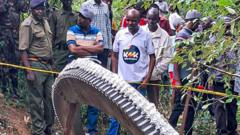The quiet New Year's Eve afternoon in Mukuku, Kenya, turned chaotic when a large, metallic object fell from the sky, creating an alarming boom that resembled a bomb blast. Stephen Mangoka, a local farmer, described the moment of impact, recalling the confusion and fear that ensued as he listened for the source of the sound—fearing it might have been gunfire.
The object, identified as a scorched metal ring, landed in a field near a riverbed, causing a stir among nearby villagers. Ann Kanuna, the landowner, recounted how the radius of the ring remained too hot to approach until it cooled down, drawing crowds who turned the scene into an impromptu selfie spot.
Local authorities were notified, and the Kenya Space Agency (KSA) quickly took interest in the unusual occurrence. Fearing theft during the night, villagers and local officers took shifts to guard the site until the KSA team arrived the following day. The object reportedly weighed more than 500 kilograms, approximately the same as a horse, and measured around 2.5 meters in diameter.
By the arrival of the KSA, and with growing media attention, it became apparent that Mukuku had never seen such a phenomenon. According to the KSA, preliminary evaluations classified the object as a "separation ring" from a space launch rocket, which normally should disintegrate upon re-entry. They stated that such debris is designed to fall in uninhabited areas, further highlighting the unexpected nature of this incident.
No injuries were reported from the crash; however, some villagers claimed structural damage to their homes, prompting calls for government action. Christine Kionga and other locals exhibited cracks in their properties, attributing the damage to the crash, while residents began expressing concerns over health risks associated with possible exposure to space debris.
Though investigations are still ongoing, initial tests revealed the metallic ring emitted low-level radiation, posing no immediate threat to health. KSA experts have taken the ring for further analysis as they continue to trace its origins. Brigadier Hillary Kipkosgey of KSA noted that determining liability for damages caused by such falling objects is complex due to international space treaties, insisting on the need for more stringent monitoring as space debris incidents rise globally.
NASA has recorded over 6,000 metric tons of space debris circling the Earth, and as the commercial space industry expands, the likelihood of occurrences like Mukuku's is expected to increase, raising alarm among residents who witnessed firsthand the risks of such celestial trash. Residents want assurance from Kenyan authorities that sufficient measures will be implemented to prevent similar scenarios in the future.
The object, identified as a scorched metal ring, landed in a field near a riverbed, causing a stir among nearby villagers. Ann Kanuna, the landowner, recounted how the radius of the ring remained too hot to approach until it cooled down, drawing crowds who turned the scene into an impromptu selfie spot.
Local authorities were notified, and the Kenya Space Agency (KSA) quickly took interest in the unusual occurrence. Fearing theft during the night, villagers and local officers took shifts to guard the site until the KSA team arrived the following day. The object reportedly weighed more than 500 kilograms, approximately the same as a horse, and measured around 2.5 meters in diameter.
By the arrival of the KSA, and with growing media attention, it became apparent that Mukuku had never seen such a phenomenon. According to the KSA, preliminary evaluations classified the object as a "separation ring" from a space launch rocket, which normally should disintegrate upon re-entry. They stated that such debris is designed to fall in uninhabited areas, further highlighting the unexpected nature of this incident.
No injuries were reported from the crash; however, some villagers claimed structural damage to their homes, prompting calls for government action. Christine Kionga and other locals exhibited cracks in their properties, attributing the damage to the crash, while residents began expressing concerns over health risks associated with possible exposure to space debris.
Though investigations are still ongoing, initial tests revealed the metallic ring emitted low-level radiation, posing no immediate threat to health. KSA experts have taken the ring for further analysis as they continue to trace its origins. Brigadier Hillary Kipkosgey of KSA noted that determining liability for damages caused by such falling objects is complex due to international space treaties, insisting on the need for more stringent monitoring as space debris incidents rise globally.
NASA has recorded over 6,000 metric tons of space debris circling the Earth, and as the commercial space industry expands, the likelihood of occurrences like Mukuku's is expected to increase, raising alarm among residents who witnessed firsthand the risks of such celestial trash. Residents want assurance from Kenyan authorities that sufficient measures will be implemented to prevent similar scenarios in the future.

















